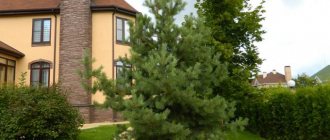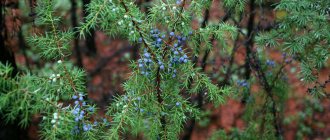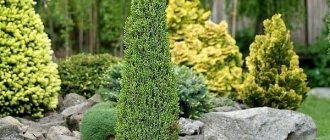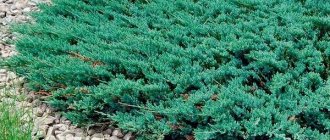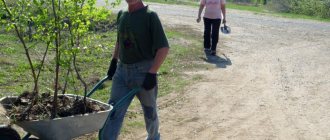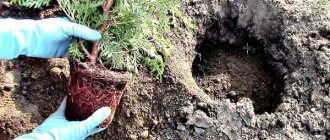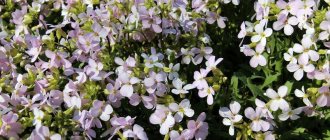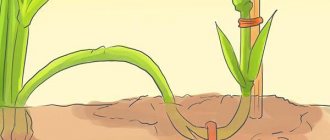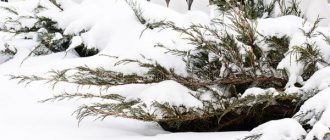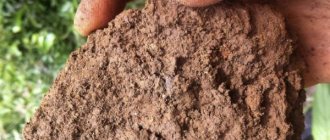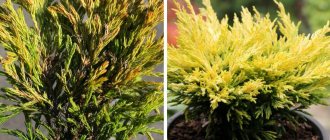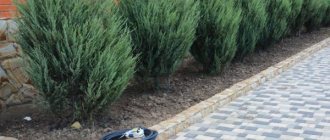Forest juniper has an external similarity to the southern cypress, and besides, it also belongs to the Cypress family, which is why many call it the northern representative of the species. This evergreen plant grows mainly in the forest, and in summer cottages it is found quite rarely, and completely in vain. After all, with its help you can create truly magnificent landscape compositions.
The strict, expressive and at the same time graceful beauty of forest juniper can decorate any garden and summer cottage.
Is it possible to plant juniper from the forest at the dacha?
The common forest juniper has several varieties; they belong to the shrubby and tall tree species. They have a decorative crown; fruits with a high concentration of essential oils are suitable for culinary use and medicinal purposes. Juniper grows in the forest on the site of clearings, in the undergrowth. Found on the slopes of mountain ranges. Feels comfortable in open areas and in partial shade.
Due to its exotic appearance, it is used for landscaping urban recreation areas and designing homestead landscapes. Hybrid species adapted to the conditions of a certain climatic zone are in great demand. You can transplant forest juniper to your dacha if conditions are created that are close to the natural environment. Initially, the choice is made; tall varieties reach up to 5 m in height, other shrubs are lower, but they have a voluminous crown. The plant is transplanted at a certain time of the year, following the recommendations for transfer.
When to replant juniper from the forest
Common juniper grows slowly, tolerates pruning calmly, and looks good on the site as a tapeworm and hedge. The culture has a lot of advantages, but there is a serious disadvantage: the forest representative of the Cypress family does not take root well after transfer. The slightest violation of the recommendations during transplantation can lead to the death of the plant.
Forest seedlings are taken no older than 3 years of age and no higher than 1 m. Work is carried out when the conifer has not entered the active phase of the growing season. Planting juniper from the forest in the spring is the best option for regions with cold winters. The work is carried out when the snow has partially melted and the ground has thawed enough to dig out the seedling. In summer, it is not recommended to move forest juniper to the site. The culture is not stress-resistant, rooting is painful, the plant loses a lot of moisture and, as a rule, forest juniper transplanted in the summer does not take root in a new place.
For the central strip, except for spring, forest juniper can be planted in autumn. The work is carried out at the end of September, when sap flow slows down and the plant enters the dormant phase.
Important! The culture is frost-resistant, it will have time to take root before the onset of cold weather and will safely overwinter.
Botanical description
Forest juniper (juníperus) is also known as forest cypress, but it is used less frequently. Botanists prefer to limit themselves to the classic Latin name. The tree belongs to the Cypress family, grows mainly in temperate climates, but due to active cultivation and cultivation in many countries of the world, it is distributed almost everywhere, except in regions with constant low temperatures. Habitat: North America, central Europe, Asia, Eastern Siberia. There are many varieties of this shrub known, and the most common in the forests of central Russia is the common juniper (Juníperus commúnis). Forest juniper can be found in mixed, deciduous and, of course, coniferous forests.
Did you know? In ancient times, juniper was used as a talisman against evil spirits. For protection, travelers took with them a small branch of the plant.
It grows on river banks, in lowlands, valleys, and clearings. Due to the density of its growth in nature, this evergreen shrub forms impenetrable thickets, the so-called juniper groups or communities. Very often, foresters take seedlings from such groups of trees, since they, receiving enough light, grow well and rarely get sick.
How to transplant juniper from the forest to the plot
Before moving a young tree or shrub, pay attention to where it grows: in open areas or partial shade. This is a necessary condition for determining a plot of land in the country. In order for the crop to take root, it is placed in the same conditions as in the forest.
Rules for digging up a seedling:
- The boundaries of the root system are determined - forest juniper forms a root and crown of the same volume.
- A landmark is made on the branch on the sunny side; you can tie a ribbon.
- Carefully dig up the bush to the depth of a spade bayonet.
- Together with the soil clod, the seedling is placed on fabric or polyethylene using the transfer method.
- Shipping material is tied over the crown and carefully pulled above the root.
The landing site is prepared in advance. Forest seedlings react poorly to an acidic composition and are neutralized. In its natural environment it can grow in wetlands; this mistake is made when transferring the crop to a personal plot. Outside its normal habitat, forest juniper does not grow on soil with high humidity.
Preparing the landing recess:
- Forest juniper is planted in a separate hole; if there are several seedlings, you can place them in a trench.
- Deepen the planting hole, focusing on the height of the root ball, up to the neck.
- Prepare nutritious soil consisting of compost, peat, sand and soil from the planting site in equal parts.
- Gravel or crushed stone is placed at the bottom, the thickness of the drainage is 15 cm, and part of the fertile mixture is placed on top.
- The seedling is placed in the center, with the marked side facing the sun.
- Fill with the rest of the mixture so that 10 cm remains to the edge of the pit, add wet sawdust, and mulch on top with a layer of leaf humus.
- Install a support and fix the forest juniper to it, you can fix the seedling on guy wires.
Important! After planting, the root collar should remain on the surface.
Along the perimeter of the planting hole, a restriction is made in the form of a small embankment to retain moisture. Water the forest seedling with water containing a growth stimulating drug. If there is a mass planting in a trench, the distance between the bushes is left at least 1.5 m.
How to care for juniper
The survival rate and full vegetation of the crop directly depend on how correctly the forest juniper is planted, as well as on the correctness of subsequent care. Even if the plant has taken root, in order for the crown to maintain its decorative appearance, the bush must be constantly watered. The main problem is that at low humidity, the needles from the lower branches dry out and fall off. With incorrect agricultural practices, you can end up with an unsightly forest juniper with needles only on the upper branches.
Watering and fertilizing
Hybrid varieties from the nursery take root well on the site; the forest representative of the species requires constant care. Watering is a primary task in agricultural technology. Do not allow the soil to become waterlogged or dry out. For the first 6 months, water the forest seedling every evening with a small volume of water; the fibrous root system loses a lot of moisture during rooting. After this period, the frequency of watering is reduced; it is enough to moisten the soil 2 times a week.
Be sure to irrigate the crown in the morning before sunrise. If a forest representative is placed in an area exposed to ultraviolet radiation, it is recommended to protect the needles from excess moisture evaporation. Forest juniper is wrapped in a wet cloth and removed in the evening. This measure is relevant until complete rooting.
If a forest seedling is planted in the fall, it must be fed with nitroammophoska in early spring. Follow the dosage indicated in the instructions; the crop reacts poorly to excess fertilizer. Feeding is carried out for 2 years. Then forest juniper does not require fertilizers.
Mulching and loosening
After transfer, the seedling is weakened and cannot fully resist fungal infection. It is necessary to constantly remove weeds, as pathogenic fungi multiply intensively in them. Loosening during weeding will provide the root system with a sufficient amount of oxygen, this factor is important for rooting.
Mulch the plant immediately after planting with sawdust, leaf humus, peat or freshly cut grass. Mulch prevents weed growth and retains moisture well. In the fall, the layer of root cover is increased, and in the spring it is completely replaced.
Trimming and shaping
Caring for forest juniper after planting includes pruning only if the plant has completely taken root. The result of the autumn transfer will be visible in May: the forest seedling has taken root or died. You can remove dry areas and give the crown the desired shape. The procedure is carried out until mass formation of young shoots. If the planting is in spring, do not touch the seedling in the fall; the first pruning is carried out next spring.
Every year a tree trunk circle is formed:
- A shallow ditch is dug along the perimeter of the crown.
- Fallen leaves are placed in it.
- A layer of lime is placed on top.
- Fill the ditch around the entire circle with earth in the form of a ridge.
Work is carried out in the fall. Forest juniper grows slowly; as the crown increases in volume, the trunk circle also increases.
Protection from diseases and pests
The forest representative of the species does not get sick in the wild; it retains this quality even when transplanted to a site. If rust appears, the only reason is the wrong location. Forest juniper is treated with copper sulfate.
The crop releases substances that are toxic to most pests. There are a number of parasitic insects that do not respond to toxic glycosides in the composition of needles. The plant is affected by:
- Juniper sawfly. When a pest appears, the plant is treated with Karbofos, and the remaining larvae are collected manually.
- Scale insects are a common parasite in low humidity. To eliminate this, daily sprinkling is carried out. Spray the forest juniper with a highly concentrated soap solution. If measures are unsuccessful, insecticides are used.
- Aphid. The insect does not appear on the conifer on its own; it is carried by ants, then they collect waste products. It is necessary to get rid of anthills on the site, then remove the places where the parasite accumulates. Without ants, the remaining insects die.
In its natural environment, forest juniper is not affected by other types of pests. Spider mites may appear in the garden area; they are eliminated with colloidal sulfur.
Preparing for winter
A seedling in the first year of growth in a different place requires shelter for the winter, regardless of what time the work was carried out. Event sequence:
- Carry out water-recharging irrigation.
- Increase the mulch layer by 15 cm.
- The branches are collected in a bundle and fixed in such a position that they do not break under the weight of snow.
- Arcs are made on top and a film is stretched, if the forest seedling is tall, they are wrapped with covering material or covered with spruce branches.
Preparatory work for winter is carried out for 2 years. Afterwards, the forest juniper is not covered, only mulched.
Pests and diseases
Wild juniper growing in natural conditions is practically not susceptible to disease. Immunity is also preserved when the plant is transplanted to a summer cottage. But sometimes, if you choose the wrong planting site, forest juniper can be susceptible to the following diseases:
- Schutte is a fungal disease manifested by the appearance of brown spots on the needles, which over time grow and merge, covering its entire surface.
Schutte poses the greatest danger to young animals
- Rust.
Juniper needles infected with rust take on a yellow tint
- Gray mold.
Gray rot causes the greatest harm to young shoots
Forest juniper produces glycosides that are toxic to most pests. But some parasitic insects are not repelled by such substances. The full development of plants can be threatened by:
- Aphid.
Ants are carriers of aphids, so it is necessary to monitor the appearance of anthills in your garden plot and remove them in a timely manner
- Shield.
Scale insects are a parasite that appears in low humidity, so daily sprinkling is recommended for preventive purposes.
- Spider mite.
An effective means of combating spider mites is the drug "Karate"
Advice from experienced gardeners
In order for the transplantation of juniper from the forest to go smoothly and for the plant to take root in a new place, it is necessary to follow certain rules. The advice of experienced gardeners is based on previous mistakes; if you eliminate them, the perennial plant will not only take root in the area, but will also withstand stress more easily.
Transfer and landing rules:
- Work is carried out in the fall before frost or in the spring, when the snow has not completely melted.
- Before removing the crop from the soil, a landmark is made on the crown on the sunny side; when placing it on the site, be sure to observe the polarity.
- Dig out the seedling carefully so as not to damage the root; the width of the soil ball should not be less than the volume of the crown. If the earthen ball is too large and transporting the juniper is difficult, it is reduced in depth.
- The plant is transferred along with the root ball; it must not be allowed to fall off. Forest juniper is completely placed in a plastic bag or wrapped in cloth.
- The planting hole is prepared in advance; drainage and a nutrient mixture are required.
- The size of the hole must correspond to the volume of the lump; voids should not be allowed; they are filled in and carefully compacted.
- The location is determined in partial shade. If planting involves an open area, daily sprinkling is necessary; forest juniper does not respond well to low air humidity, especially in the first year of growth in a new location.
- It is undesirable to plant forest juniper next to buildings; the branches of the plant are fragile, and water or snow falling from the roof can cause significant damage to the crown.
- After planting, it is necessary to water with a growth stimulating drug.
Attention! Fruit trees, especially apple trees, should not be allowed to be adjacent to juniper.
Apple trees provoke the development of rust, the plant is weak after transfer, the disease will develop within a few weeks, and it will be difficult to save the forest juniper.
Care
This plant does not require serious care.
At the same time, it is necessary to follow simple rules:
- In spring the plant needs to be fertilized;
- the circle around the trunk must be kept clean, weeds must be removed and mulched;
- mulch is placed on geotextiles;
- in winter, the crown is tied with twine, because lumps of snow can ruin the appearance of the plant;
- varieties with blue needles should be protected from the sun by covering the plant with opaque material;
- you need to prune the plant in a timely manner and remove dead branches (so new ones will begin to grow faster;
- Young branches must be protected from frost.
Young plants need watering. Adults tolerate drought conditions well. Plants need to be watered up to 3 times a month. In hot weather, they are sprayed once every 10 days. Approximately 1-3 buckets of water are used per tree for irrigation.
Experienced gardeners recommend paying special attention to the plant for six months after planting. All this time, you should water the tree in a timely manner and eliminate overgrown weeds, which are a source of disease.
Pruning of the plant is carried out if it is necessary to make a green hedge out of it. In other cases, pruning is not carried out. When pruning, you must be extremely careful not to remove excess shoots - recovery will take a very long time. It is necessary to carry out sanitary pruning; it does not damage the crown of the plant and does not cause further diseases.
This is interesting: Pullorosis in chickens: signs and treatment
